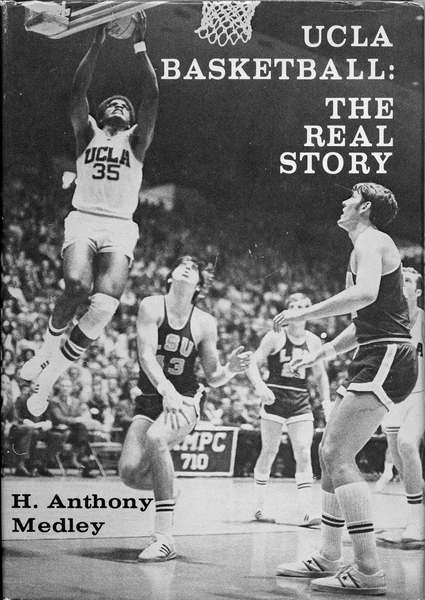|
Out of print for more than 30 years, now available for the first time as an eBook, this is the controversial story of John Wooden's first 25 years and first 8 NCAA Championships as UCLA Head Basketball Coach. This is the only book that gives a true picture of the character of John Wooden and the influence of his assistant, Jerry Norman, whose contributions Wooden ignored and tried to bury. Compiled with more than 40 hours of interviews with Coach Wooden, learn about the man behind the coach. The players tell their their stories in their own words. Click the book to read the first chapter and for ordering information. Also available on Kindle. |
|
Rush (9/10) by Tony Medley Runtime 123 minutes. OK for children. If I had to be second best at something, I’d go into another business. Bette Davis Ron Howard, like most directors, has had his hits and misses. The misses, The Da Vinci Code (2006) and The Dilemma (2011), have been monumental horrors for the viewing audience. But, fortunately, his hits have been far more numerous. In this one he proves that he really knows how to make a terrifically entertaining movie when he puts his mind to it. This is the story based on the 1976 rivalry between Formula 1 race drivers Niki Lauda (Daniel Brühl) and James Hunt (Chris Hemsworth), neither of whom could stand to be second best to the other in 1976. Brühl and Hemsworth are both astonishing lookalikes for the people they were playing (shots of the real Hunt and Lauda are shown at the end). The film, the idea of screenwriter Peter Morgan, who wrote it on spec and then tried to sell it, tells the story of the 1976 competition between the two by creating a personal tension between them that might be a figment of the imaginations of Morgan and Howard. The drivers are pictured as acutely antagonistic towards one another. Although Morgan worked with Lauda in writing his script, I’m not sure that the depiction of the personal feelings between the two men as portrayed in the film is a plot device or something you can take to the bank. Whichever it is, it works, mainly due to the wonderful acting of the two main actors. Further, this is a Hollywood movie and literary license is not something that should be particularly troubling so long as the license doesn’t lead one to believe something substantial that is not true. Here it does not. Even better are the sound (Danny Hambrook), which intensifies the speed and danger of the racetrack, and the cinematography (Anthony Dod Mantle). Modern TV coverage of races, like the Indy 500, have cameras in the cars which try to capture the speed of the cars, but they really don’t, because what is shown is the car in relation to the other cars. Since the cars are all moving at about the same speed, the speed is relative to the surroundings and since the surroundings are moving at the same speed, the cameras don’t capture the same sensation that is caught by stationary cameras. While Mantle has some cameras in cars, they are mostly stationary showing the cars whizzing by, so the speed is much more impressive and the exceptional sounds of the huge, powerful engines make the speed and danger palpable. The only thing that was jarring in the film was the recreation of the start of the Nürburgring race. There are at least three shots of the start of the race looking down the track at the cars lined up for the start with the stands on either side and storm clouds in the sky interspaced throughout the film. The scenes appear unrealistically contrived, reminiscent of the background for the opening scenes of Casablanca (1942), which look laughably camp today. These scenes seem out of place in a movie that otherwise shines with brilliance. Because of the brilliance of the rest of the film, I would like to think that Howard and Mantle intentionally shot these scenes that are clearly different from all the other scenes in the movie, and which appear three times, as a warning that something terrible is about to happen, and that the difference in cinematography is a precursor to that, like Hitchcock's ominous shots of Norman Bates' home on the hill in Psycho (1960) and the shots of the windmill in Foreign Correspondent (1940). That would make these scenes consistent with the quality of the rest of the film. In addition, Howard also pays nice homage to Frank Capra’s 1934 mega-hit, multiple Oscar®-winner It Happened One Night by turning the Clark Gable-Claudette Colbert hitch-hiking scene on its ear. The acting is superb. Hemsworth and Brühl capture the essence of their characters spot on. Olivia Wilde (Suzy Miller, Hunt’s wife) is so sexy and beautiful that it doesn’t strain anybody’s credulity to believe that she went on to be one of Richard Burton’s lovers. Alexandra Maria Lara (Maureen Lauda, Niki’s first wife) is a divergence to Suzy, pretty, not beautiful, but sweet and caring, as much a contrast with her counterpart, Hunt’s wife, as the two drivers are a contrast with one another. While this is a racing movie, it is not inundated or overwhelmed by the racing scenes. It is mainly a character study of the two men who are competing with each other, and it is fascinating. September 17, 2013 |
|
|
